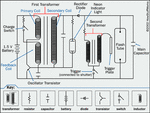AYahoo
Newbie level 3

Hi All, It has been long time since I used my electronic knowledge and I'm a little bit rusted 
I have a simple camera flash circuit (similar to this):

I have 330v 102uf capacitor as the main capacitor, and the signal measured across the capacitor is:

As you can see in the picture there are two pulses, one short one (highlighted in green color) and the second one that follows it immediately, and then the charge.
the volatge goes from 330v to 280v on the first pulse and then from 280v to 50v (roughly), I need to preserve the duration of the pulses, but change the "lamp" from flashtube to LED (I know the intensity is different, I don't need the intensity). As I know the LED will work on 3v so I need to change the voltage of the output, I thought All I need to do is replace the flashtube with a resistor & a led in series and the led will work, but I'm not sure if I'm correct and if the "timing" of the pulses will still be the same.
Also what resistor should I use? and what should I do with the trigger plate? (that is connected to the flashtube).
Thanks in advance!
AYahoo
I have a simple camera flash circuit (similar to this):

I have 330v 102uf capacitor as the main capacitor, and the signal measured across the capacitor is:

As you can see in the picture there are two pulses, one short one (highlighted in green color) and the second one that follows it immediately, and then the charge.
the volatge goes from 330v to 280v on the first pulse and then from 280v to 50v (roughly), I need to preserve the duration of the pulses, but change the "lamp" from flashtube to LED (I know the intensity is different, I don't need the intensity). As I know the LED will work on 3v so I need to change the voltage of the output, I thought All I need to do is replace the flashtube with a resistor & a led in series and the led will work, but I'm not sure if I'm correct and if the "timing" of the pulses will still be the same.
Also what resistor should I use? and what should I do with the trigger plate? (that is connected to the flashtube).
Thanks in advance!
AYahoo

